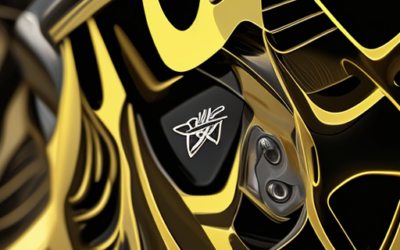Racing Wheels: The Ultimate Guide to High-Speed Transportation

1. What is racing wheels?
Racing wheels are high-performance tires designed specifically for use on vehicles that are used for racing or high-speed driving. They are made with a variety of materials, including carbon fiber, Kevlar, and other lightweight materials, which reduce rotational inertia and improve overall handling. These tires have a unique tread pattern that allows them to grip the road better at high speeds, reducing the risk of skidding or losing control. In addition, racing wheels are typically much wider than standard tires, providing additional stability and traction. Overall, racing wheels are designed to enhance the performance of a vehicle, allowing it to reach its maximum speed potential.

2. History of racing wheels
Racing wheels have been around since the early days of automotive racing. They were first used in the early 1900s in Europe, where they quickly gained popularity among racecar drivers. These early racing wheels were made from solid steel and were designed to withstand the high speeds and intense competition of auto racing. As technology advanced, so did the design of racing wheels. Today, racing wheels come in a variety of materials, including aluminum, magnesium, and carbon fiber, and are designed to provide maximum performance and durability. Whether you’re a professional racer or just looking to upgrade your daily driver, racing wheels are an essential part of high-speed transportation.

3. Types of racing wheels
There are several types of racing wheels available on the market, each designed to provide specific benefits and performance characteristics. Here are some of the most common types of racing wheels:
1. Lightweight racing wheels: These wheels are designed to reduce rotational mass and improve acceleration and overall handling. They are typically made from materials such as carbon fiber or magnesium, which are lighter than traditional steel or aluminum alloys.
2. Deep dish racing wheels: These wheels have a deeper profile than standard wheels, which allows them to fit larger brake calipers and provide better stopping power. They also tend to offer improved stability at high speeds.
3. Centerlock racing wheels: These wheels feature a central locking mechanism that allows them to be secured to the hub without the use of lug nuts. This provides a more secure attachment and can help reduce weight and improve aerodynamics.
4. Drift racing wheels: These wheels are designed specifically for drifting and feature a unique tread pattern that helps generate smoke and provides excellent grip on the track.
5. Slick racing wheels: These wheels are used in drag racing and other high-speed applications where maximum traction is required. They are typically made from lightweight materials and feature a smooth surface to reduce friction and improve speed.
6. Open-wheel racing wheels: These wheels are used in open-wheel racing cars and feature a flat design with no spokes. They are lightweight and provide excellent strength and durability.
7. Cup racing wheels: These wheels are designed for use in stock car racing and feature a flat surface with a small lip around the edge. They are designed to provide maximum grip on the track and are often used in high-speed turns.
8. Off-road racing wheels: These wheels are designed for use in off-road racing and feature a larger diameter and aggressive tread pattern to provide excellent traction on rough terrain.

4. Benefits of using racing wheels
Racing wheels offer numerous benefits to drivers who want to enhance their vehicle’s performance. Here are some of the advantages of using racing wheels:
1. Improved handling: Racing wheels are designed with a low profile and a lightweight construction, which allows them to provide better grip on the road. This means that your vehicle will have improved handling, making it easier to take corners at high speeds and negotiate challenging terrain.
2. Increased speed: Racing wheels are made from lightweight materials such as aluminum or magnesium, which reduces the overall weight of your vehicle. This reduction in weight means that your car will be able to reach higher speeds than before, giving you a competitive edge on the track.
3. Better braking: Racing wheels have a larger diameter than standard wheels, which provides better airflow around the brakes. This results in cooler and more consistent braking, even under heavy use. Additionally, the lower profile of racing wheels can improve the efficiency of your braking system, allowing you to stop faster and more reliably.
4. Enhanced appearance: Racing wheels come in a variety of styles and designs, allowing you to customize the look of your vehicle to match your personality and preferences. Whether you prefer sleek and aggressive or classic and timeless, there is a racing wheel option that will suit your needs.
5. Increased durability: Racing wheels are built to withstand the demands of high-speed driving, and are often constructed with stronger materials than standard wheels. This means that they are less likely to crack or warp under extreme conditions, providing added peace of mind for drivers who push their vehicles to the limit.

5. How to choose the right racing wheel for your vehicle
When it comes to choosing the right racing wheel for your vehicle, there are several factors to consider. Firstly, you need to determine the type of racing wheel that best suits your needs. There are two main types of racing wheels: steel and aluminum. Steel racing wheels are durable and resistant to corrosion, making them ideal for off-road use or in areas with harsh weather conditions. Aluminum racing wheels, on the other hand, are lightweight and provide better handling, making them perfect for track use or on paved roads.
Another important factor to consider is the size of the racing wheel. Racing wheels come in various sizes, ranging from 15 inches to 20 inches. The size you choose will depend on your vehicle’s stock wheel size and the type of racing you plan to do. For example, if you’re planning to do drifting, you may want to go with smaller wheels to improve your steering response. However, if you’re doing track racing, larger wheels may be more suitable as they offer better stability at high speeds.
In addition to size, you should also consider the weight of the racing wheel. Lighter wheels are generally preferred for track use as they offer better acceleration and braking performance. However, if you’re planning to use your racing wheel for off-road purposes, heavier wheels may be more suitable as they provide better durability and resistance to punctures.
Finally, you should consider the price of the racing wheel. Racing wheels can range from affordable to very expensive, depending on the quality and features. It’s important to set a budget beforehand and choose a racing wheel that fits within your price range without compromising on quality.

6. Installing racing wheels
Installing racing wheels can seem like a daunting task, but with the right tools and some basic knowledge, it can be done easily. Here are the steps to follow:
1. Start by removing the old wheels and tires from your vehicle. This may require the use of a lug wrench or a special tool specific to your vehicle. Be sure to dispose of the old tires properly.
2. Clean the hubcaps and the area around the new racing wheel mounting location with a degreaser solution. This will ensure a good connection between the wheel and the hubcap.
3. Place the new racing wheel onto the hubcap and secure it in place with the lug nuts. Make sure the wheel is centered and straight before tightening the lug nuts.
4. Use a torque wrench to tighten the lug nuts to the manufacturer’s specifications. This will ensure that the wheel is securely fastened to the vehicle.
5. Repeat the process for the opposite side of the vehicle.
6. Lower the vehicle to the ground if necessary to check the alignment of the new racing wheel. If the wheel is not aligned correctly, adjust the wheel accordingly.
7. Check the brakes and rotors to make sure they are compatible with the new racing wheel. If not, replace them accordingly.
8. Put on the new tire and inflate it to the recommended pressure.
9. Test drive the vehicle to ensure that everything is working properly and there are no issues with the new racing wheel.

7. Maintaining racing wheels
To ensure that your racing wheels continue to perform at their best, it is important to maintain them properly. This includes regularly inspecting them for any damage or wear, cleaning them as needed, and ensuring they are properly inflated. It is also recommended to store your racing wheels in a cool, dry place when not in use to prevent any damage from moisture or extreme temperatures. By following these simple maintenance steps, you can help extend the life of your racing wheels and keep your vehicle running smoothly.

8. Safety considerations when using racing wheels
It is important to prioritize safety when using racing wheels. Here are some key points to keep in mind:
1. Always follow local laws and regulations regarding racing wheels. Some areas may have restrictions on their use or require special permits.
2. Use high-quality racing wheels and tires that are designed for high-speed performance. This will help ensure that your vehicle handles properly and can withstand the demands of racing.
3. Be aware of your surroundings at all times while driving. Other vehicles, pedestrians, and obstacles can pose a risk, especially at high speeds.
4. Wear appropriate safety gear, such as a helmet and racing gloves. This will help protect you in case of an accident or sudden stop.
5. Never exceed the recommended speed limit for your vehicle and racing wheels. This can cause dangerous instability and put yourself and others at risk.
6. Always drive defensively and be prepared for unexpected situations. This means staying alert, avoiding distractions, and being aware of potential hazards.
7. Have a reliable backup plan in case something goes wrong with your racing wheels or vehicle. This could include a spare tire or a tow truck.
By following these safety guidelines, you can enjoy the thrill of high-speed transportation while keeping yourself and others safe.

9. Racing wheel upgrades
Racing wheel upgrades refer to the process of upgrading or replacing the stock wheels on your vehicle with high-performance racing wheels. This can include adding spinners, changing the color, or upgrading to a different material. These upgrades can improve the appearance of your vehicle while also enhancing its performance on the track. When considering racing wheel upgrades, it’s important to keep in mind the type of racing you plan to participate in, as well as your budget and personal preferences. There are many options available, so take the time to research and find the best upgrade for your needs.

10. Conclusion
In conclusion, racing wheels offer numerous benefits for high-speed transportation enthusiasts. They provide improved handling, acceleration, and braking performance, as well as enhanced appearance and style. When choosing the right racing wheel for your vehicle, it’s important to consider factors such as size, weight, and compatibility with your current tires. Proper installation and maintenance can ensure optimal performance and longevity. Additionally, there are various upgrade options available for those looking to take their racing experience to the next level. Overall, racing wheels are a great investment for anyone seeking to enhance their driving experience and push their vehicle’s limits.



